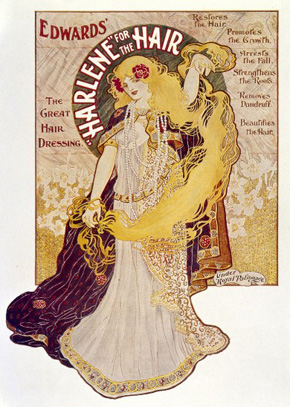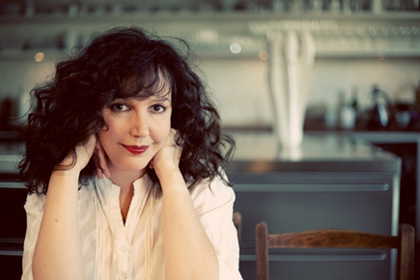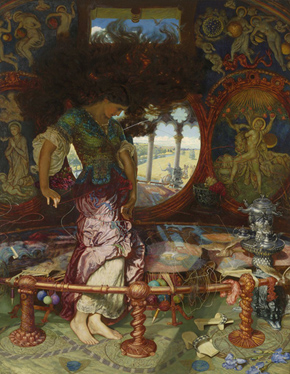Medusa myths
by Michelle LovricWhen I was a child, my biology textbooks consigned hair to the erotic Little League: “A secondary sexual characteristic” was the dry definition. Now I’ve written a novel that rehabilitates hair to the sexual A-List.
It started with the question “What if there were seven sisters with hair flowing to the ground?” This question is instantly problematised and accessorised by the 1870s setting of The True & Splendid History of the Harristown Sisters. In those days it was indecent for adult female hair to be seen ‘undressed’ outside the bedroom. In public, it had to be brushed, plaited, tonged, pinned and otherwise tortured into properness.
Such hairstyles were, I believe, elaborate helmets against unruly desires. For what do we first notice and always remember about the women of the Pre-Raphaelite portraits? The innovation that made them shockingly alluring in their time – and ours – is the abundant, loose hair thrusting almost out of the frames. It was for their hair, as much as their sensual lips and insolently self-absorbed gazes, that these women were branded ‘stunners’. The sight of their hair was enough to stun men to silence.
Dante Gabriel Rossetti’s Lady Lilith and La Pia de’ Tolomei grew serpentine hair with a visible energy of its own. The phallic nature of such hair, as Freud would later read in the Medusa, represented a threat and at the same time a provocation to men. Voluminous, uncontrolled, space-filling hair made demands, expressed female vitality and sexual vigour.
In Browning’s ‘The Flight of the Duchess’, the gypsy queen’s life force flows
Into her very hair, back swerving
Over each shoulder, loose and abundant,
As her head thrown back showed the white throat curving;
And the very tresses shared in the pleasure,
Moving to the mystic measure,
Bounding as the bosom bounded.
The sexual demands of women, as evidenced in this new loosened hair, were frequently depicted in ways that were exaggerated or grotesque.
Rossetti made male fears explicit in his verses about Lady Lilith, Adam’s first wife. In ‘Eden Bower’ (Poems, 1870) she’s a rippling Godiva of a serpent-woman, spreading her hair as a snare for her lovers or as a noose to strangle them.
In her influential 1984 essay, ‘The Power of Hair in the Victorian Imagination’, Elisabeth Gitter explored the obsession with long hair in the latter half of the 19th century. Hair descriptions, feverish and detailed as they were, could go either way. Destiny forked in front of long-tressed girls, clear as a parting in their hair.
Manticory Swiney is the narrator of The True & Splendid History of the Harristown Sisters. She and her six siblings are born in Famined poverty. All their riches grow on their heads. Manticory’s a reader. By the time she’s thirteen, she understands that something is going on with hair. Even in her Irish backwater, she’s aware of a Europe on fire for what grows on women’s heads. Poets are writing hair and love, hair and death. Hair and more hair is filling up the margins of books and the frames of paintings till they are fit to burst.
Like Rapunzel’s prince, the artists’ models – girlish nobodies like ourselves – were climbing their own ropes of hair to a higher state. Their very names were known, alongside the artists’: girls born in dubious circumstances and with nothing and no more morals than were necessary… As that summer dwindled into autumn, I began to straighten my back and walk on my bare feet with my head held higher. I did not know where my hair would lead, but it seemed that a great story lay in store: it simply was not yet legible to me.
Contemporary scholar Galia Ofek divides Victorian depictions of long-haired women into two types: Medusas, knowing, dangerous and wild, and golden-tressed mortal angels who were sexually innocent and often needed saving. The latters’ soft hair could also provide salvation for eager men.
The hero of Browning’s ‘Pauline’ wants his love to bend over him, creating a tent of hair, a sanctuary from all harm. Baudelaire in ‘Her Hair’ and Poe in ‘Annie’ would long for the same thing. Rossetti and Yeats would use it too.
Beneath her sheltering hair,
In the warm silence near her breast,
Our kisses and our sobs shall sink to rest
wrote Dante Gabriel Rossetti in ‘The Stream’s Secret’. He had married the most famous flame-haired Pre-Raphaelite stunner of them all, Elizabeth Siddal. In a touching essay, art critic Griselda Pollock recalls finding a coil of Siddal’s coppery hair in an archive, exhumed along with the book of poems the poet had buried with her. Regretting his decision, he had poor Lizzie dug up so he could reclaim his work.
Donne’s “bracelet of bright hair about the bone” reminds us that hair is the one human relic that survives the corruption of death in all its original beauty. We also see hair’s immortality in its function as an age-old, indispensable motif in ballads and folk tales. Combing of the hair, spinning and weaving were all associated with woman’s power to create, to build a family, in other words to shape a narrative for herself.
William Holman Hunt’s tense, ambiguous ‘The Lady of Shalott’ shows her barefoot at the centre of loom. Her hair billows upwards like dark sails as she dances with her thread. We cannot know if her frantic creativity expresses her own desires, or her despair at being snared in this picturesque trap.
Sometimes a woman’s hair becomes her tongue, as in the murder ballad ‘The Cruel Sister’, in which a dark-haired sister kills her blonde sibling in order to steal her lover. But the victim’s breastbone, strung with her hair, becomes a harp that sings the story of the murder, convicting the murderess.
But a female who spins can also be likened to a spider. A woman who combs her hair can be a siren, like Lorelei, luring men to death. In myth and legend, whenever women deliberately let their hair down, trouble followed. Manticory notes:
But, as the fairy tales taught, whenever womanly parts draw eyes to them, young women shall also know danger. Our Swiney hair also aligned us with Rapunzel, betrayed, hurt, confined in frail frame of her own helpless body as much as in the tower from which she so badly needed to be rescued. Our hair knitted us to vanquished Medusa, tongueless mermaids, the stripped and shamed Lady Godiva.
When they were stripped naked, the hair of Saint Agnes and Mary Magdalen grew miraculously to protect their modesty. Lady Godiva shielded herself the same way. But in Western art, the abundance of their hair can also be seen as sexual provocation. Even when supposed to cover the body, hair serves to remind us of the nakedness beneath. It is a veil so loose and soft that a finger can part it.
This dichotomy continues in the image of golden hair. Gold connotes preciousness and immortality. It is pure; it does not tarnish like silver. Equated with moral wholesomeness, it is also repeatedly likened to the ripening sheaf of corn or the halo of the Virgin and the golden thread that often connects Her gaze to the Christ Child.
But a long-haired virgin is not the opposite of sex… she is an opportunity, a challenge. Rapunzel lowers her golden hair, allowing the prince to climb it to reach her narrow tower and take possession of her. Mélisande, heroine of Debussy’s opera, lets her hair flow over and around the ecstatic body of her lover Pelléas.
Not surprisingly, the second half of the 19th century saw a burgeoning of hair products. Sadly, this was an opportunity for the quacks to profit on the insecurities of women who increasingly held the domestic purse strings. Madame Fox’s Life for the Hair, “unrivalled in its delicacy and agreeableness”, was nevertheless largely made of petroleum. Other products were just as dangerous.

Print advertisement for Edward’s Harlene, 1890s. Wellcome Library
While researching at the Wellcome Library, I pored through boxes of Victorian hair ephemera. The packaging, now separated from the dubious contents, is preserved in acid-free transparent sleeves. Through my hands flowed perfect examples of all the old quack tricks of foreign names, exotic ingredients, extravagant claims: Hall’s Vegetable Sicilian Hair Renewer, Doktor Müller’s Haarwuchs-Elixier, Rowland’s Macassar Oil, Pomade Hongroise. In America, the Seven Sutherland Sisters, like my Irish Swineys, grow rich peddling a worthless hair restorer in a show in which they let their hair tumble to the ground in front of avid audiences. The old formulas have translated easily to television advertising today. Think Laboratoire Garnier, Nutrileum, extract of pearls…
Hair is of course a debatable land. It is partly inside us, partly outside us. Hair cannot feel pain. It grows back if cut. Is it not a magic substance, in that we can cut, shape and colour our hair in ways that no other organ can be altered? It’s the first signifier of age. Despite its tricksiness and mutability, hair retains its intimate identity, the forensic scientist’s tool of choice.
In his Studies in the Psychology of Sex, Havelock Ellis explained, “Hair is at once an animal and a human product, while it may be separated from the body and possesses the qualities of a stuff.”
Hair is what we share with the mammals. The more hair, the closer we are to beasts who mate vigorously and without shame, and mostly without scruple as to number of partners or couplings. Our carnal portals are marked by hair.
The head is always the focal point of our body, to look out of and to look at. Hair, historically, became a stage – the front of house, the stereotypical marker, a performance in its own right. We know the monk by his tonsure, the Hassidic Jew by his ringlets, the sex kitten by her babylike downy locks – pet-able as a kitten. Indians remove the scalp of the enemy; collaborators are shaved.
Artists of the Surrealist movement played with the notion of externalising the beast inside us. Meret Oppenheim designed werewolf gloves and fur-footed sandals.
James Frazer devoted many pages to hair in The Golden Bough: A Study in Magic and Religion (1890). He recorded the widespread belief in the sympathetic magic invested in hair (and nail clippings). The hair was sacred to the spirit of the head, to be molested at peril. It was a matter of anxiety when it was cut. “The chief of the Namosi in Fiji always ate a man by way of precaution when his hair was cut,” wrote Frazer.
In many cultures, cut hair had to be hidden in a place where neither sun nor moon could shine on it, or burnt lest witches used it to raise tempests. It was a traditional belief of the Irish that the hairs on our heads were all numbered by the Almighty, who would expect to account for each one on the Day of Judgement. Village women would wind hair into the thatch of their cottages for safe storage until then.
Hair has become a highly charged subject in academic and artistic circles, with some writers arguing that hair represents the primal aggression of the id. Others draw on the concept of weaving in Freudian theory as metaphor for the dream-work of the subconscious. Freud also saw weaving as a mask for “genital deficiency”. Cutting of a woman’s hair is a kind of castration, according to Freud, who also saw a similarity with Chinese foot-binding.
Hair has been deployed as a metaphor for the umbilical cord that joins mother and unborn child, or as the embodiment of boundaries between the inner and outer. The cutting or plucking of hair connotes bodily and metaphysical separation. The Anglo-French artist Alice Anderson works with both dolls and doll hair, exploring these ideas.
Marina Warner claims that Joan of Arc died for her haircut. The cropped hair and the cross-dressing, Warner says, were provocation enough. In From the Beast to the Blonde (Vintage, 1995), Warner also describes the ritual role of hair in mourning. Frida Kahlo cut her hair after Diego Riviera abandoned her, and painted herself in his suit with her lopped hair around her.
Was there ever such a useful source of metaphor as human hair? As serviceable a sexual totem. And let’s just revisit that trope: whenever a woman lets down her hair, trouble follows. It’s not just a metaphor. Feel the breeze, hear the slither of hair. Smell its perfume. Be afraid.
 Michelle Lovric is the author of Carnevale, The Floating Book, The Remedy (longlisted for the 2005 Orange Prize for Fiction), The Book of Human Skin and two children’s novels. She combines her fiction work with editing, designing and producing literary anthologies including her own translations of Latin and Italian poetry. She divides her time between London and Venice, and holds workshops with published writers of poetry and prose, fiction and memoir. The True & Splendid History of the Harristown Sisters is published by Bloomsbury in hardback and eBook. Read more.
Michelle Lovric is the author of Carnevale, The Floating Book, The Remedy (longlisted for the 2005 Orange Prize for Fiction), The Book of Human Skin and two children’s novels. She combines her fiction work with editing, designing and producing literary anthologies including her own translations of Latin and Italian poetry. She divides her time between London and Venice, and holds workshops with published writers of poetry and prose, fiction and memoir. The True & Splendid History of the Harristown Sisters is published by Bloomsbury in hardback and eBook. Read more.
michellelovric.com
Author portrait © Marianne Taylor



